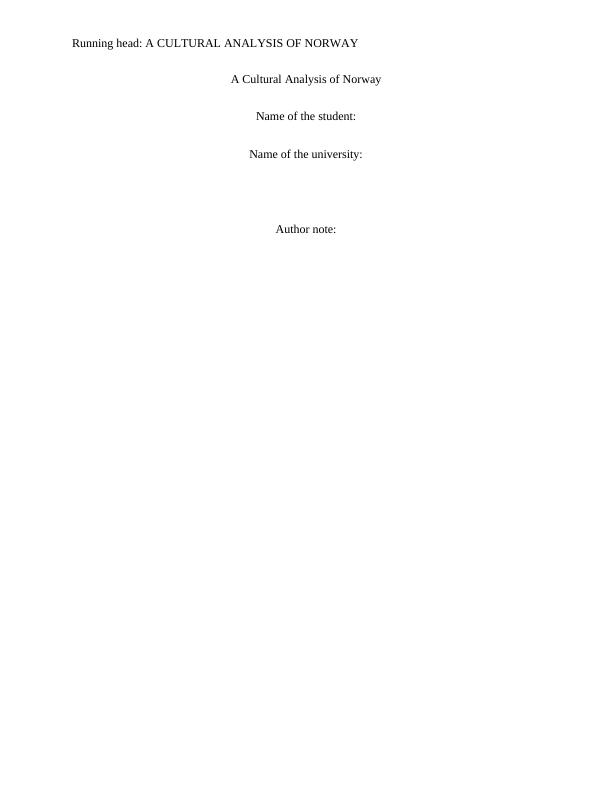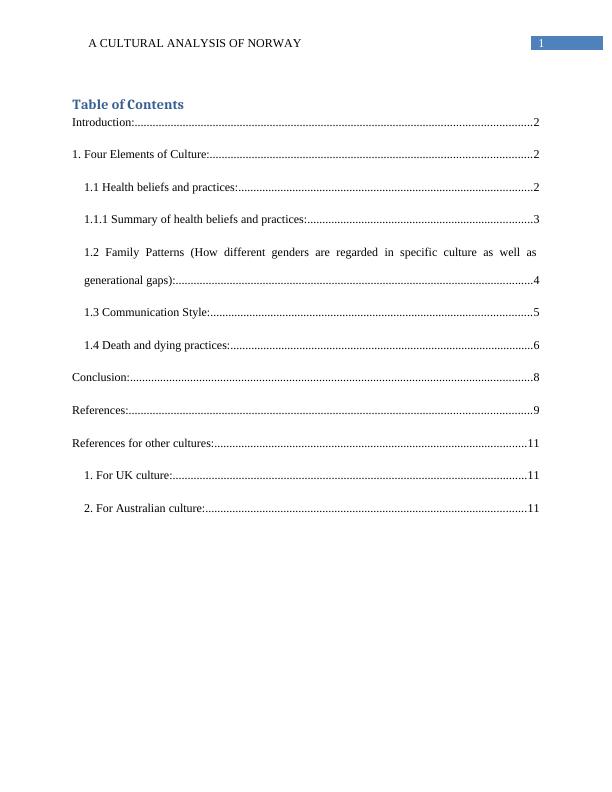A Cultural Analysis of Norway
12 Pages2795 Words35 Views
Added on 2021-04-21
A Cultural Analysis of Norway
Added on 2021-04-21
ShareRelated Documents
Running head: A CULTURAL ANALYSIS OF NORWAYA Cultural Analysis of NorwayName of the student:Name of the university: Author note:

1A CULTURAL ANALYSIS OF NORWAYTable of ContentsIntroduction:....................................................................................................................................21. Four Elements of Culture:...........................................................................................................21.1 Health beliefs and practices:..................................................................................................21.1.1 Summary of health beliefs and practices:...........................................................................31.2 Family Patterns (How different genders are regarded in specific culture as well asgenerational gaps):.......................................................................................................................41.3 Communication Style:...........................................................................................................51.4 Death and dying practices:.....................................................................................................6Conclusion:......................................................................................................................................8References:......................................................................................................................................9References for other cultures:........................................................................................................111. For UK culture:......................................................................................................................112. For Australian culture:...........................................................................................................11

2A CULTURAL ANALYSIS OF NORWAYIntroduction: The study is based on analysing the culture of Norway from different perspectives like itspeople’s beliefs on health related facts, their family patterns, the communication style and thedeath & dying practices. Culture represents an identity in particular in foreign countries. There isan ample number of countries on this globe and most of them are different to each other inregards to culture (Bendixen et al., 2017). The study is aimed at understanding a culture whichmay be different to many; however, this is not just the purpose for the research. It is mainly forenhancing the understanding level of graduates who are expected to face a varied type of culturesat the workplace. 1. Four Elements of Culture: 1.1 Health beliefs and practices: Norway is one of few countries which are rated high in terms of health values. They areone of the fittest populations on this globe. The average life expectancy rate is also very high andis equal to nearly seventy-eight years. The modern beliefs have largely replaced the traditionalmedical beliefs that had existed in the eighteenth and the nineteenth centuries. They are wellversed in good health facilities. The government does also support the healthcare sector bymaking 15 percent investments in the industry (Theorell et al., 2015). The people living in Norway had carried the very same feeling for healing option as thisis in some other parts of the world. They have always relied on the modern form of treatment. Inthe ancient times, the Norwegian people had the approachability to alternative medicines;however, they had considered it after all popular treatment method had failed. However, their

3A CULTURAL ANALYSIS OF NORWAYviews had started to take a different shape since the foundation of Norwegian HealersAssociationin 1994 (Larsen, 2015). People then started to think of alternative medicine and hadconsulted the healing while not bothering for the traditional format of healing. They also had nosuch trust in the complementary form of treatment. It all happened in 1998 when the Ministry ofHealth and Social Affairs appointed a committee consisting of no healers but only the doctorsfrom traditional medicine profession. They were being asked to publish a report on healing. Theyhad found that there are some scientific facts present in the alternative medicine and healing.Today, healers are employed in most of the institutions and hospitals of social care. “NAFKAM”was then being established by the Ministry of Health and Social Affairs to administer theRegistry of Exceptional Course of Disease (Ljunggren, 2017). The “NAFKAM” was being formed in Norway, so that, the approach could be monitored.The government had identified the incrementing demands for treatment in parallel with thecomplementary and the alternative medicines. This is why they had wanted to monitor the CAM(Complementary & Alternative Medicines) on critical diseases, so that, the viability level couldbe identified. The treatment techniques were being found as suitable in some cases whereas itlacked in few areas. The purpose behind the formation of “NAFKAM” was to identify whetherboth the treatments should exist or only the CAM or conventional medicine alone (Whitworth,2015). 1.1.1 Summary of health beliefs and practices: To summarise, the people living in Norwegian uses the different kinds of techniquesranging from the conventional form of treatment to alternative medicines and the complementarytreatment (CAM). After the formation of “NAFKAM” in 1994, they had actually started

End of preview
Want to access all the pages? Upload your documents or become a member.
Related Documents
Cultural Competence in Nursinglg...
|11
|2933
|184
The traditional healing practices in Africalg...
|4
|768
|16
Cultural Competence in Practicelg...
|28
|2221
|143
Traditional Medicines in Tanzanialg...
|6
|1163
|14
The Cultural Practices of South Korealg...
|15
|3462
|317
Hispanic Culture: Health Beliefs, Family Patterns, Communication Stylelg...
|18
|1652
|169
